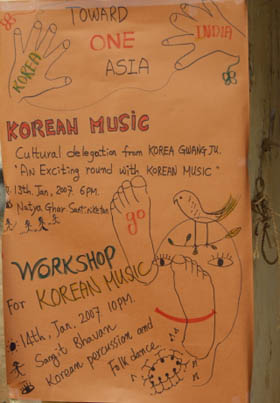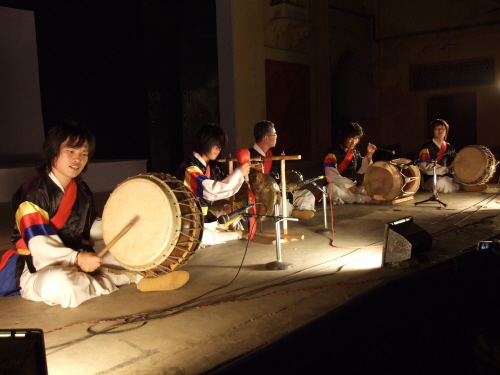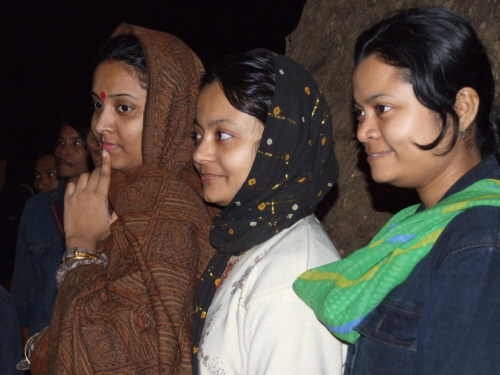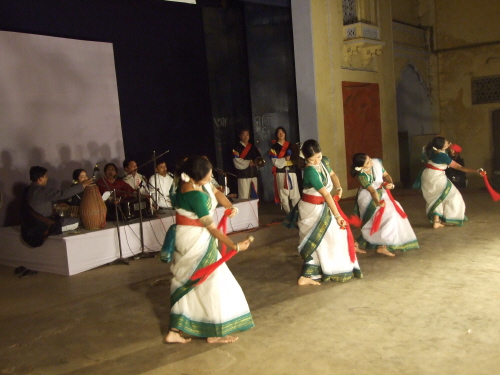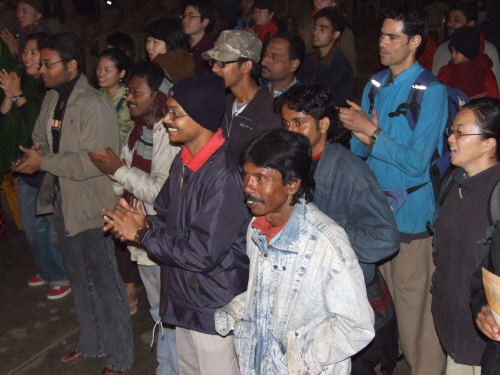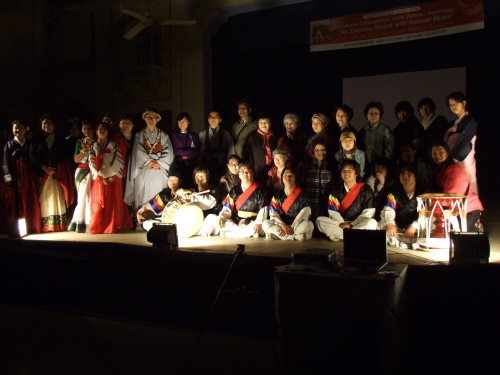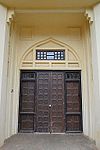인도 인문학 여행 이야기 8 – 산티니케탄(Santiniketan): 영원한 시성 타고르- 비스바 바
라티 대학(Visva- Bharati University ), 타고르 문학(Tagore literature)
“내 마음속의 학교는 하나의 행복한 가정인 동시에 신성한 사원이어야 한다. 가르침은 경
건한 삶의 일부이기 때문이다. 나는 경건한 삶의 기억을 신에게 바치기 위해서 번거로운
곳이 아닌 산티니케탄을 교육 장소로 선택했다.” 라빈드라나트 타고르
산티니케탄Santiniketan 자연학교 비스바 바라티 대학VisvaBharati
이번 여행은 시인이자 극작가, 소설가였으며 화가였고, 교육자이기도 했던 타고르, 그리고 1913년 동양인 최초로 노벨
문학상을 받은 타고르의 정신이 새겨져 있는 산티니케탄이다. 콜카타에서 154km 떨어진 북서쪽에 있는 작은 시골 마
을이다. 이곳은 19세기 중엽까지는 세속을 떠나 수행의 터로서 산티니케탄아스라마라 불렸다고 한다. 벵골어로 ‘평화의 땅’이라는 뜻인 산티니게탄은 인도를 대표하는 자연 교육 마을이다. 샨티니케탄(Santiniketan)에는 비스바 바라티 (Visva-Bharati)라는 학교가 있다. 타고르(Rabindranath Tagore)는 산티니케탄에서 1901년에 인도 전통학교 ‘아쉬람(Ashram)’ 형태로 5명의 학생과 함께 작은 숲 속 학교로 시작했다. 이것이 바로 비스바 바라티의 시작으로 보면 된다. 당시에는 시험도 없었고, 학비도 없었다. 그 뒤 거듭 발전을 걸쳐 1921년에 비스바 바라티대학이 설립되었다. 이제는 유치원에서 대학교까지 모든 교육과정을 가진 국립대로서 인도 교육의 요람으로 성장했고 이곳에 타고르가 남긴 유품과 관련 자료를 가장 많이 보관한 곳으로 알려졌다. 여기서 우리는 잠시 인도가 국부로 여기는 타고르가 어떤 사람이었는가를 알아보는 것도 흥미로울 것 같다.
타고르(Rabindranath Tagore, 1861~1941)
는 인도가 낳은 사상가이자 철학자이다. 또한,
미술, 음악 등에 조예가 깊은 예술가이기도 했
다. 그는 1861년 5월 7일 콜카타의 명문 브라
만 가정
에서 막내로 태어났고 이미 여덟 살 때 처음 시를 섰고 열다섯 살 때부터 시작(詩
作)을 시작하였다. 그에 따르면 인간성의 자아(自我)의 무한한 가능성을 일깨우
고 개발하는 것을 교육이라고 보고 있다. 그는 법학을 공부하면서 자격증만을 얻
으려는 비교육적 대학 제도에 큰 실망을 하고 끝내 변호사 공부를 포기한다. 그리
고 문학 작품을 탐독하기에 이른다. 특히, 어릴 때부터 ‘기탄잘리(Gitanjali)’와 벵
골어로 서정시들을 쓰는 것을 좋아했다. 1890년에는 첫 시집 '마나시(Manasi)
도 출판하기도 했고 희곡 작품도 발표할 정도로 문학에 소질이 있었다. 하지만,
타고르의 시작(詩作)은 그 당시 인도인들에게는 인기가 없었다. 그 이유는 상층
지배계급 표준어인 고전적 산스크리트어가 아니라 지방 속어로 간주하여 경시를
받았던 벵골어로 쓰였기 때문이다. 그런데도 노벨문학상 수상의 소감에서 ‘모국어인 벵골어를 잘 유지하는 데 공헌한 점’이라고 할 정도로 타고르는 벵골어를 사랑한 듯하다. 참으로 아이러니하다.
그렇다면 과연 타고르(Tagore)가 그리는 학교는 어떤 학교였을까? 아마 자연과 함께하는 숲속 학교일 것이다. 수업은 항상 자연과 함께 이루어져 아이들이 자연의 섭리를 배우도록 인도하는 학교 말이다. 이런 교육 방법은 획일적인 학습을 탈피하여 스스로가 해답을 찾아가도록 이끄는 방법으로 그들 자신 고유의 본성과 재능을 스스로 발현되도록 돕는 데 있다. 실제로 필자가 방문할 당시에도 숲 속 나무 아래에서 편안하게 아이들과 선생이 수업에 열중하는 모습을 볼 수 있었다. 평화롭게 커다란 망고나무 그늘에서 말이다. 마치 한국에서 가끔 하는 야외 수업을 보는 듯했다. 게다가 특이한 것은 학교를 오고 가는 이동 수단도 거의 자전거를 주로 이용한다. 이 모든 것이 학교 설립 취지에 맞게 운영되는 듯 보인다. 캠퍼스 안과 주위에는 여전히 진흙 벽과 초가지붕이 존재하여 한국의 옛날 시골 풍경을 보는 것 같다. 필자가 언
뜻 보기에도 학교 전체 분위기가 자연 친화적이라는 것을 금방 알아차릴 수 있었다. 그렇다고 학교가 학문적이지 않다는 이야기는 아니다. 분명한 것은 벵골에 수많은 사람이 이곳에 깊은 경의를 표할 정도로 비스바 바라티(VisvaBharati)는 학문적이고 특출하다. 이것은 아마 타고르의 독특한 교육철학 때문일 것이다.
타고르(Tagore)는 아마 유년 시절 일방적인 교육에 불
만을 느끼고 있는 듯하다. 인도에 도입한 서구식 교육
방식에 염증을 느낀 것이 아닐까 생각해본다. 기존의
학교들과는 다른 교육이념으로 아이들을 가르치려는
사명감을 보면 알 수 있다. 결국 샨티니케탄
(Santiniketan)에 작은 학교를 만들었다. 비스바 바라
티 말이다. 교실 벽에 갇힌 교육에 문제를 잘 알고 있어
서인지 숲 속 교육을 지향하고 실천한 것이다. 간디도
타고르와 비슷한 생각을 했다고 한다. 『데미안』을 쓴
헤르만 헤세도 기존의 교육 패러다임과 교육 방법론을 비판하면서 폭넓은 책 읽기와 열정적 글쓰기를 통해 자아실현의
여행길을 열어나가야 한다고 언급하면서 실천했다. 이성과 감성의 상호보완을 끌어냄으로 말이다. 타고르 말을 들어보
면 그의 교육철학을 알 수 있다. “무엇을 배웠는지는 기억나지 않고 배운 것만 기억한다.” 교육에 대한 타고르의 생각은
모든 사람은 천재이고 모든 학생이 한꺼번에 성장할 수는 없다는 논리이다. 일리가 있는 이야기이다. 사람마다 자신만
의 강점이 존재하고 있기 때문이다. 그래서 그는 Viva-Bharati에서 새로운 학습시스템을 고안했는지도 모른다. 이 학습
시스템의 특징은 학생과 교사가 모두 만족할 때까지 프로그램을 지속할 수 있도록 하는 것이다. 예컨대 비스바 바라티
(Visva-Bharati) 학교 근처에는 학교 선생들이 거주하는 구루뽈리라는 곳이 있어서 학생들이 필요할 때 시간과 관계없
이 언제든지 도움을 받을 수 있다. 한 가족처럼 말이다. 또 한 가지 특이한 점은 비스바 바라티(Visva-Bharati)에서는
선생님을 다다(오빠), 디디(언니)라고 부른다. 음식점 주인, 인력거도 모두 ‘다다’ 거나 ‘디디’라는 사실이다. 직업에 상
관없이 호칭이 같다. 아마 비스바 바라티에서 교육은 일방적 가르침이 아니라 삶의 지혜라는 의미를 나타낸다. 이 모든
것은 타고르의 뜻에 따른 것이다.
이처럼 타고르의 가르침이 비스바 바라티 곳곳에 배어있는 듯
하다. 왜 우리는 교육이 남과 경쟁하는 것만이라고 생각하는가?
과연 경쟁 없는 교육이 가능할지 묻는다면, 샨티니케탄의 비스
바 바라티가 바로 그런 곳이라고 말하고 싶다. 잘하는 것보다는
함께 사는 법을 터득하도록 가르치는 학교, 경쟁보단 협력을,
지식보다는 지혜를 전달하는 곳이 아닌가 생각해본다. 이런 인
도인의 교육은 유대인의 교육과 유사하다. 유대인 탈무드 교육
말이다. 탈무드 교육의 핵심은 어린 시절부터 아이들이 끊임없이 생각하고 말하도록 하는 것이다. 인도인들도 자신의
지식을 쌓고 축적된 지식을 가지고 토론을 통해 이를 종합하여 지혜를 터득한다. 그리고 그 지혜를 지속해서 발전시켜
잠재력을 개발할 기회가 주어진다는 점에서 유사하다. 타고르는 이런 말을 했다. ‘어리석은 자는 서두르고 영리한 자는
기다리고 현명한 자는 정원으로 간다’라는 말처럼 비스바 바라티가 세계화 속에서 변함없이 그의 정체성을 잃지 않기를
기대해 본다. 현재 비스바 바라티라는 초·중등교육을 담당하는 파타바반, 미술대학인 깔라바반, 중국어 대학인 치나바
반 등 마을 곳곳에 총 51개의 단과대학 및 교육기관이 분포해 있다. 하바드대학교 교수이자 노벨 경제학상 수상자인 아
미르티아 센(Amartya Kumar Sen)이 유년 시절 수학했던 학교이기도 하다.
타고르 시집 기탄잘리
여기서 우리는 타고르의 시 세계를 탐험해 보자. 타고르에게 언어가
무기였다. 즉 벵골어 말이다. 그는 자기 민족적 언어인 벵골어의 위
상을 시를 통해 세계적으로 끌어 올렸다. 그리고 지금은 인도의 가
장 위대한 문학 전통이 되었다. 1910년에 처음 출판된 타고르의 유
명한 시집『기탄잘리』도 벵골어 되어있다. 『기탄잘리』는 157편의
서정시를 묶어 여기에 57편을 추리고 여기에 다른 시를 첨가하여
모두 103편을 영어로 번역하였다. 그리고 1912년에 영국에서 다
시 출판했다. 무명의 인도 시인이었던 타고르에게 동양 최초의 노벨
문학상을 안겨준 시집도 바로『기탄잘리』이다.『기탄잘리』는 인간과
신의 관계를 사랑하는 연인의 관계로 승화한 103편의 산문시를 담
고 있다. 주로 신, 고독, 사랑, 삶, 여행을 노래한다. 벵골 지방에는 '바울'이라는 떠돌이 음유시인들이 이었는데 타고르
는 이들에게 영감을 받았다고 한다. 그들은 거리에서 신과 진리를 말하고 시를 노래하며 춤을 추었다. 여기서 기탄잘리
의 ‘기트(GIT)’라는 뜻은 노래이고, ‘안잘리(ANJALI)’는 두 손 모아 바친다는 의미이다. 그래서 기탄잘리는 ‘님에게 바치
는 노래’라는 의미로 여기에서 ‘님’은 신이고 연인이며 자아이다.
구미전자공고 기본소득한국네트워크
존재 인도 기후위기 김삼식 텃밭
구미 타자 힌두교 체육대회 정치
단호박 권력 국립2회 상추 사유화
뜨르농장
===================================
최근댓글
댓글 감사합니다 따뜻한 봄날 맞이하세요
댓글 감사합니다 춘분 추분이 빨간날이…
일본은 춘분 추분이 빨간날이라 오늘 휴…
댓글 감사합니다 봄입니다 따뜻한 봄날 …
<기탄자리> 제35 번째 시는 우리에게 잘 알려진 시이다 이 시는 타고르가 영국에 항거하는 인도인들을
위로하기 위해 쓴 시로서 우리나라 일제 식민지 시대를 연상케 한다 감상해 보자
마음에 두려움 없이
머리를 높이 치켜들 수 있는 곳
지식이 자유로울 수 있는 곳
작은 칸으로 세계가 나누어지지 않는 곳
말씀이 진리의 속 깊은 곳에서 나오는 곳
피곤을 모르는 노력이 완성을 향하여 팔 뻗는 곳
이상의 맑은 흐름이
무의미한 관습의 메마른 사막에 꺼져 들지 않는 곳
님의 인도로 마음과 생각과 행위가 더욱 발전하는 곳
그런 자유의 천국으로
나의 조국이 깨어나게 하소서, 나의 임이시여.
타고르의 동양적 감수성과 영적인 세계관은 당시 서구 사회에 큰 충격을 줄 만큼 대단했다고 한다. 흔히 타고르의 예술
세계는 우파니샤드의 철학에 뿌리내리고 있다. 우파니샤드는 대략적인 내용은 다른 지면에서 다룰 예정이다. 영국 식
민지 당시 그는 우파니샤드에서 주장하는 개인의 해방을 민족의 해방으로 끌어올렸다는 평이다. 그에게 있어 민족의
해방은 곧 개인의 해방에 대한 간절한 염원이었을 것이다. 또한, 타고르는 간디와 함께 인도 국부로 존경받고 있다. 그
이유는 여러 가지다. 그는 인도, 방글라데시의 국가 작사도 했고, 예이츠, 에즈라 파운드, 로맹 롤랑 등 서양 문인들뿐
아니라 과학자 아인슈타인과도 교류하였다. 그리고 물리학자 하이젠베르크에게도 동양철학을 가르칠 정도로 다방면에
지식이 해박했다. 문학도 그랬다. 영국의 유명한 시인이며 노벨문학상 수상자인 예이츠는 1912년에 타고르의 시 원고
를 읽어보고 크게 감동했다고 한다. ‘기탄잘리’를 두고 인간 존재의 본연을 다룬 책으로 “누구나 읽지 않을 수 없는 마력
을 지녔다”라고 격찬했다. 다음은 예이츠 말이다. “나는 여러 날 동안 이 번역된 원고 뭉치를 가지고 다니면서 기차 안에
서도, 버스에서도, 혹은 식당에서도 읽었으며, 또 낯선 사람이 내가 얼마나 감동하는지 알아볼까 두려워 가끔 그 원고를
덮어두어야 했다.”라는 말에서 보듯이 시집이 출간되자마자 영국을 통해 온 유럽에서 폭발적 반응을 얻었다. 그리고 예
이츠의 추천 덕분에 마침내 타고르는 아시아인 최초로 노벨문학상을 받았다.
타고르의 동방의 등불 패자의 노래The Song of the Defeated
이쯤하고 우리는 잠시 고개를 돌려 우리나라와 연관된 타고르 시에 대해서 알아보자. 아주 흥미로울 것 같다. 타고르는
최남선의 요청으로 한국에 대한 두 편을 시를 썼다고 알려졌다. <동방의 등불>과 <패자의 노래>이다. 하지만 <패자의
노래>가 최남선이 요청한 시로 알려졌지만, 그 이전에 이미 시집에 있던 시로 밝혀졌고 <동방의 등불> 역시 출처가 예
매한다는 학계의 주장이다. 타고르는 1929년 4월에 일본 도쿄를 방문한 적이 있는데 거기서 문학 강연을 했다. 이때
동아일보사의 도쿄지국의 기자가 타고르를 만났다고 한다. 그 기자는 타고르에게 한국을 방문해 줄 수 없느냐, 고 질문했고 타고르는 방문 요청은 고맙지만, 일정상 시간이
없다고 하면서 <동방의 등불>을 써 주었다고 한다. 그
는 캐나다를 가는 도중에 일본에 들렀다.
《패자의 노래》도 1916년 타고르의 첫 번째 일본 방
문 시『청춘』을 발간하던 최남선의 부탁을 받아 『청
춘』의 기자가 타고르를 만났던 일본 유학생 진학문의
요청으로 타고르가 당시 우리나라 ‘조선’에 보냈던 시
이다. 때마침 도쿄에 머물고 있던 최남선은 제국대학
강연회에서 타고르를 만났고 한 달 뒤에는 유학생 진학문이 요코하마에서 타고르와 두 차례 면담했다고 한다. 얼마 후
타고르는 약속대로 자신의 사진과 친필 사인, 그리고 시를 보내왔다. 이듬해 소개된 시가 ‘패자의 노래’이다. 이 시는
1917년 『청춘』의 11월호에《쫓긴 이의 노래》라는 제목으로 영문 텍스트와 함께 번역, 소개되었다. 패자의 노래’ 원제
는 ‘The Song of the Defeated’다. ‘박진영 성균관대 교수에 의하면 이 시는 타고르가 새로 지은 것이 아닐뿐더러 식민
지 망국민을 노래한 것도 아니라고 주장한다. 즉, ‘조선’을 위해 별도로 쓴 시가 아니라 1916년 1월 1일에 발간된 『열
매 모으기』(Fruit Gathering)에 85번째로 수록된 시라는 것이다. 아마 타고르는 일제 점령기에 패자가 누구를 가리키
는지 분명히 알았고 그래서 고심해서 그 시를 골랐음이 틀림없다.
패자敗者의 노래 타고르18611941
퇴각의 길목을 지키면서 패자의 노래를 부르라고
선생은 나에게 요구하나니
패자란 남몰래 선생이 사랑하는 약혼녀이기 때문이어라.
어두운 빛 너울을 그녀가 쓰고서 사람에게 얼굴을 가리나!
가슴 안에는 어두운 빛에 빛나는 보석을 간직하였도다.
그녀는 밝은 빛에 버림 당했거니와 밤에는 반짝이는 눈물을 흘리며
이슬에 젖은 꽃 손에 들고 바라고 있네.
신에게 광명을 가져다주기를 말없이 눈을 내리감은 채로
바람과 함께 불평의 소리 나도는 그의 집을 그녀는 뒤로하였네.
그러나, 별들은 고욕을 나타내는 사랑스러운 얼굴을 지닌
그녀의 영원한 사랑의 노래에 억양을 준다….
고독의 방문이 열렸구나, 부름이 왔네,
그래서 가슴을 두근거리네, 어두운 가운데서, 뜻있는 시각의 불안 가운데서.
타고르 입장에서 인도와 마찬가지로 조선도 ‘the Defeated’(패자)의 나라였다. 이 시에서 ‘패자’는 신이 비밀히 찾는 신
부이며 낮에는 버림 당했지만, 밤은 이슬 젖은 꽃들과 함께 그녀를 기다리고 있다고 묘사하고 있다. 이런 면에서 역설적
으로 이 시는 패배나 모욕을 강조하기보다는 식민지 무력 정복이라는 사실을 은연중에 드러내고 있다. 타고르만큼 아
시아에서 알려진 시인은 거의 없다. 위에서 언급했듯이 그는 전통적으로 사용하는 문어체인 고대 산스크리트어에서 벗
어나 구어체 문장을 주로 사용하여 시문학에 생명을 불어넣었다. 그 결과 훨씬 감동적으로 다가온다는 평을 받고 있다.
서정적인 시풍 역시도 모든 사람에게 큰 감동을 안겨 주었다. 또한 민중들의 삶을 반영한 단편소설들도 최고의 걸작들
이다. 특히 한국인에게는 ‘동방의 등불’이라는 시가 친숙하다. 타고르가 건너 준 쪽지에는 어떤 제목도 없었다고 한다.
처음에 주요한 역시도 《조선에 부탁》이라는 제목을 그냥 붙었을 뿐이다. 하지만 아이러니하게 주요한이 선택한《동방
의 등불》,《동방의 등촉》, 《동방의 불빛》 등이 이 시의 제목이 되었다.
Best CRM Software
Stay Ahead In Your Industry With
Innovative CRM Software Solutions
CRM Software Solutions Open
그러면 이제《동방의 등불》을 음미해 보자
동방의 등불
일찍이 아시아의 황금 시기에
빛나던 등불의 하나였던 코리아,
그 등불 다시 한번 켜지는 날에
너는 동방의 밝은 빛이 되리라.”
In the golden age of Asia
Korea was one of its lamp bearers
And the lamp is waiting to be lighted once again
For the illumination of the East
타고르가 조선을 위해 써준 이 짧은 시에는 평소 그가 동방(the East)에 대해 가지고 있던 견해가 반영되어 있음을 알
수 있다. 그는 『민족주의』(Nationalism, 1917)라는 자신의 저서에서 “동방에서 영원한 빛이 다시 빛날 것이다. 동방은
인류 역사의 아침 태양이 태어난 곳이다. 아시아의 가장 동쪽 지평선에 이미 동이 트고 태양이 떠오르지 않았다고 누가
확신할 수 있겠는가? 그리고 나는 나의 선조 현인들처럼 다시 한번 온 세계를 밝힐 동방의 일출에 경의를 표한다.”라고
하면서 동방에 대해 예언자적인 기대를 은근히 암시하고 있다. 아래는 타고르의『기탄잘리』 일부분이다. 타고르의 시를
이해하는 데 도움이 될 듯하다.
1
당신은 나를 영원하게 하셨으니, 그것이 당신의 기쁨입니다. 이 연약
한 배를 당신은 끊김 없이 비우시고 신선한 생명으로 영원히 채우고
있습니다.
이 가냘픈 갈대의 피리를 당신은 언덕과 골짜기 너머로 지니고 다니
셨으며, 이 피리로 영원히 새로운 노래를 부르고 있습니다. 당신의
영원히 사라지지 않는 손길에 나의 작은 가슴은 즐거움에 젖어 들어
서 말로 표현할 수 없는 소리를 외칩니다.
그칠 줄 모르는 당신의 선물을, 나는 이처럼 작은 두 손으로 받아 들
고 있습니다. 오랜 세월은 지나가도 당신은 여전히 채우고 있습니다.
그러나 아직도 채울 수 있는 자리는 나에게 남아 있습니다.
2.
당신이 나에게 노래를 부르라고 명령하실 때, 나의 가슴은 자랑스러움으로 인하여 터질 것만 같았습니다.
나는 당신의 얼굴을 바라보면서 뜨거운 눈물을 흘립니다. 나의 생명 속에 들여있는 거칠고 어긋난 모든
것들이 한 줄기의 아름다운 화음으로 녹아들고 있습니다.
나의 찬미는 바다를 날아가는 새처럼 즐겁게 날개를 펼칩니다.
나는 당신이 나의 노래를 듣고 있다는 사실을 알고 있습니다.
나는 오직 노래를 부르는 사람으로 내가 당신 앞에 나갈 수 있다는 것을 알고 있습니다.
활짝 펼친 내 노래의 날개 끝으로 나는 감히 닿을 수 없는 당신의 발을 어루만집니다.
노래를 부르는 즐거움에 젖어서, 나는 자아를 잃어버리고 나의 주인 당신을 친구라고 부릅니다.
3
당신이 어떻게 노래를 하는지 나는 알 수가 없습니다. 고요한 기쁨 속에서 나는 언제나 당신의 음악에 귀
를 기울입니다.
당신이 부르시는 노래의 빛이 이 세상을 환하게 비추고 있습니다. 당신의 음악에서 흘러나오는 거룩한 생
명의 숨결이 하늘을 가득 채우고 있습니다. 성스러운 음악의 물결이 온갖 장애물을 넘어 달려갑니다.
나의 마음은 당신과 함께 노래를 부르는 것을 열망하고 있습니다. 그렇지만 헛되이 가슴만 태우고 있을
뿐입니다. 나는 지금 목소리조차 나오지 않습니다.
나의 말이 노래로 변하지 않기 때문에 눈물을 흘리고 있습니다. 당신은 끊임없이 물결치는 음악의 함정에
나를 빠지도록 만들었습니다.
4.
내 생명의 근원이여, 나는 언제나 몸을 깨끗하게 하고 있습니다. 당신의 손길이 나의 몸을 어루만지고 있
다는 사실을 알기 때문입니다.
나는 언제나 내 생각에서 모든 거짓을 씻어내기 위하여 노력하고 있습니다. 내 마음속에 깃들여 있는 이
성의 등불에 불을 밝힌 진리가 당신이라는 사실을 알기 때문입니다.
나는 나의 가슴에서 모든 죄악을 물리치고 사랑이 피어나도록 노력하고 있습니다. 내 가슴 장 깊은 곳, 그
곳에 당신이 머무르고 있다는 사실을 알기 때문입니다.
그래서 당신이 나의 행동으로 나타나도록 노력하고 있습니다. 나에게 행동하는 힘을 주는 것으로 당신의
권능이라는 사실을 알기 때문입니다.
이제 글을 마무리하고자 한다. 지금까지 타고르의 정신적 터전인 산티니
케탄(Santiniketan)을 둘러보고 흔적을 더듬었다. 그리고 그의 교육철학
과 우리나라와 관련된 시도 음미해 보았다. 여전히 놀라움은 타고르의 종
교가 힌두교도였음에도 불구하고, 시나 문학에서 어느 한 특정 종교의 냄
새가 전혀 없다는 사실이다. 그의 작품에도 아주 보편적인 삶과 죽음의
문제를 다루어졌을 뿐이다. 그래서 모든 종교인에게 거부감이 없는 것 같
다. 또한, 인도에서 타고르라는 사람은 우리가 생각하는 이상으로 훨씬
더 존재감이 있다. 시뿐만 아니라 소설, 희곡, 음악, 회화, 사상, 철학 등
모든 방면에서 인도인에서 영향을 끼쳤고 공헌도 했다. 그리고 동양인으
로 최초로 노벨문학상까지 수상했기 때문일 것이다. 그 명성답게 서울 대학로에도 타고르 흉상이 동방의 등불 시비와
함께 서 있다. 그리고 해마다 남이섬에서는 타고르 탄생 기념행사도 개최한다. 타고르 그림 작품이 전시되고 신과의 교
감, 자연의 생명력에 심취했던 타고르의 이미지 세계를 감상할 수 있다. 게다가 타고르가 작곡한 댄스 드라마도 선보이
고 인도 전통춤 까닥(Kathak) 댄스 공연도 빼놓을 수 없는 볼거리라고 한다. 좋은 축제인 듯하다.
주인도 한국문화원 한국실에서도 타고르 시집 ‘기탄잘리’의 한국어 번역본, ‘동방의 등불’이 실린 한국 교과서와 신문 사
본, 타고르 관련 한국 도서 등이 전시되고, 가락국 시조 김수로왕과 결혼한 인도 아유타국 공주 허황옥 관련 설화, 고대
인도를 답사하고 여행기 ‘왕오천축국전’을 남긴 신라 승려 혜초 등 양국의 문화교류 역사 등도 소개하기도 한다. 타고르
가 산티니케탄을 교육 장소 택한 이유인 “내 마음속의 학교는 하나의 행복한 가정인 동시에 신성한 사원이어야 한다. 가
르침은 경건한 삶의 일부이기 때문이다.”라는 글과 함께 산티니케탄(Santiniketan) 타고르의 흔적을 뒤로하고 이제 다
음 여행 목적지인 인도 인문학 여행 아홉 번째로 남인도 마드라스(첸나이)로 향한다.
4 구독하기 응원하기
혜윰 인문학 > 인문학여행 카테고리의 다른 글
인도 인문학 여행 이야기 9 마드라스첸나이 남인도 드라비다 문화 까빨리슈와라르카팔레스와라 사
원 세인트 조지타운St George Town 마드라스 고등법원Madras High Court 산토메 대성당 (26)
20230203
